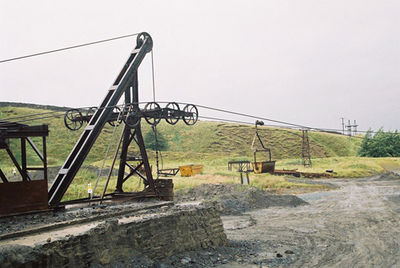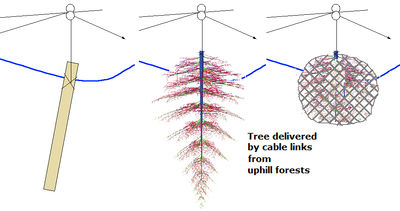Aerial Ropeways
Simple, inexpensive yet powerful technology. One of the most energy-efficient forms of transporting goods and people. Relatively easy and quick to set up, operate and take down again. The most common materials used for constructing ropeways were first wood/fiber and then steel/steel ropes. The introduction of steel ropes and electric motors was a major efficiency boost, so these should be the preferred option.
Advantages and Drawbacks
Advantages
- Structural efficiency. Ropeways are tensile structures - structures loaded primarily in tension - which makes them inherently more efficient than structures with significant bending and compressive loads.
- Economy. Mainly a result of structural efficiency (above), but also the result of having multiple cars propelled by a single power-plant and drive mechanism. This reduces both construction and maintenance costs. The use of a single operator for an entire ropeway is a further saving, in labor cost. On level ground, the cost of ropeways is competitive with narrow-gauge railroads; in the mountains the ropeway is far superior.
- Ability to handle large slopes. Ropeways and cableways (cable cranes) can handle large slopes, and large differences in elevation. Where a road or railroad needs switchbacks or tunnels, a ropeway travels straight up and down the fall line. The old cliff railways in England and ski resort ropeways in the mountains take advantage of this feature.
- Low footprint. The fact that only narrow-based vertical supports are needed at intervals, leaving the rest of the ground free, makes it possible for ropeways to be constructed in built-up areas and in places where there is intense competition for land use.
- Safety. There is no danger of collision between cars, or between ropeway cars and other modes of transportation - except aircraft of course.
Drawbacks
- Ropeways are strictly straight-line devices. Where a change of direction is needed, an angle-station must be constructed and the ropeway split into two sections at that point. This represents a considerable increase in cost.
- Where a change in vertical direction is needed (e.g. cresting a hill or peak), a pressure frame must be built to take the downward force from the cables, plus the weight of the cars. This too represents a cost increase.
- Ropeways are not as versatile as ground vehicles in handling oversize or overweight loads. They work best on divisible loads like people, bulk goods and identical small items that can be grouped or separated for optimal loading.
- Speeds are low (but throughput can still be high if loads can be distributed along the cable, close together).
Gravity-powered ropeway
In mountainous regions, a ropeway may be powered by gravity alone (see links below, Nepal). This has opened up opportunities for high-volume, low-cost trade between high-altitude mountain communities and low-altitude communities. Costs are fixed, and are dictated only by the cost of the ropeway infrastructure. There are no energy costs. A mountain community may deliver construction materials (e.g. stones, bricks and sand; all with low embodied energy) or minerals. A lower-altitude region may deliver finished products or biomass/biofuels to the mountainous region.
Open source ropeway hardware for large-scale biochar transport
Biochar is becoming increasingly recognized as an important soil amendment and strategy to reverse climate change. Some regions of the world, such as the semi-arid drylands, have little capacity for producing biomass and biochar. Other regions, such as forests, produce an abundance of biomass but it is often at risk of wildfires, releasing gigatons of carbon dioxide into the atmosphere as part of the normal carbon cycle. Therefore, the production of biochar in forests has been proposed, followed by transport to nearby biomass-poor regions. If done by ground transport (trucks, rail), this would be prohibitively expensive and would make no sense from an emissions point of view.
Aerial ropeways may change that equation, as they have many qualities needed to transport large amounts of biochar energy-efficiently and inexpensively. The energy released from biochar production (heat) can drive a heat engine that powers the ropeway. Even topsoil could be transported in this way, for rapid regeneration of degraded soils.
Some open source hardware development is needed, and may include:
- very large bins of sheet metal with steel supports (biochar is light-weight and bulky); bins are designed to prevent carbon dust that might explode (need to be covered/closed)
- poles that can be made of steel pipes (for the drylands) or wood (in forests); design for rapid take-down and re-assembly in different location
- steel rope with standardized diameter to be used everywhere
- standardized wheels (possibly sand-cast or CNC-machined ?), i.e. a shape that works well with the size of steel rope chosen
- development of social and financial structures to facilitate these ropeways (i.e. to address NIMBYism by financially including landholders who provide the land)
Rocky Mountains Example
In the Rocky Mountains, there are billions of tons of dead wood that resulted from pine beetle kills. But turning that wood into biochar and leaving it locally would only make it last until the next wildfire (unless buried deep underground). If this carbon could be transported out into an agricultural area without wildfires, that would keep the carbon out of the atmosphere permanently. Same situation in Siberia, where wildfires release billions of tons of CO2 into the atmosphere every year. What if this carbon could be turned into biochar and then transported to a non-forested area, say in Central Asia or Mongolia ?
Biochar ropeway / refinery integrated system
- transport biomass on ropeway to a central (small) biorefinery
- pyrolysis and biochar production, liquid fuel production (central small refinery should ideally be located near waterways for further transport, or at least have rail access)
- transport biochar back to the field
- last mile (on/off ramp): cargo bicycle, horsepower, small machines
Urban-rural transport
Modern ropeways could be installed to facilitate urban-rural transport. There is vast potential in re-establishing nutrient cycling systems betweeen country and city. Processed organic waste from the city (compost, humanure, ash) would be be transported back to the country to be used as fertilizer. The process could even be powered by the energy that is still contained in the waste (by heat engine, such as steam engine, biogas-fired turbine, etc.). There could also be farmers' markets and CSA (community supported agriculture) distribution points along the ropeway, selling products from the country to the city.
Cable Monorails
Conventional ropeways typically operate at speeds of about five meters/second, or about 20 kilometers per hour. Significantly higher speeds are not practical due to increased losses in the traction cable and its pulleys, guides and so forth. Another limit imposed by the traction cable is on ropeway length. There are long ropeways, to be sure, but for practical reasons these are subdivided into two or more sections, each with its own traction cable and motor drive.
To achieve an increase in speed and the possibility of carrying passengers and freight between cities in competition with railways and roads, while keeping the advantages of a primarily tensile structure, requires some changes, namely:
- The cars are self-propelled, eliminating the traction rope;
- the cars run on a straight, semirigid track suspended from the support cable, instead of directly on the cable. The effect is similar to a suspension bridge, with the track taking the place of the bridge deck.
The result is a cable monorail. For an example of this kind of system, see: http://www.aerobus.com.
Aerobus Problems
Aerobus, however, was designed primarily as an urban "people mover," so it doesn't meet all our requirements for an interurban transportation system.
One problem is that the track is allowed to bow upwards between supports when there is no car running on it. This leads to significant vertical distortion of the track as the car passes; the rate at which this can be allowed to happen limits the permissible speed of the car. This problem can be solved by replacing the simple suspension system with a two-way cable truss (see Irvine, 1981) which essentially preloads the suspension system and keeps the track straight whether loaded or unloaded.
Another problem is curves: Aerobus uses a rigid rail for changes in direction. This is expensive structurally and economically and favors small-radius curves which impose speed limits and difficulties with the car's suspension. What is needed is a method of supporting gradual curves with cables alone, just like the straightaways, along with a track design that allows the cars to "bank" or lean into the curve - in other words, a track that is torsionally soft without sacrifice of tensile strength. This problem has not yet been solved, but is probably solvable and is under study.
References
- Die Zweiseil-Pendelbahn 100 (ZP 100). Swiss Army, 1954, Technical Regulation 57.125
- Die Zweiseil-Pendelbahn 200 (ZP 200). Swiss Army, 1957, Technical Regulation 57.126 d
- Die Zweiseil-Pendelbahn 300 (ZP 300). Swiss Army, 1955, Technical Regulation 57.127 d
- Die Zweiseil-Pendelbahn 500 (ZP 500). Swiss Army, 1957, Technical Regulation 57.128 d
- Die Einseil-Pendelbahn 100 (EP 100). Swiss Army, 1956, Technical Regulation 57.129 d
- Czitary, Eugen: Seilschwebebahnen. Springer Verlag, 1951. First edition.
- Dean, Frederick E.: Famous Cableways of the World. Frederick Muller, 1958
- Rigging Techniques, Procedures and Applications. US Department of the Army, October 1995, FM 5-125
- Pierre, L.: Etude sur les Transporteurs Aériens. Librairie Polytechnique - Ch. Béranger, Editeur, 1909
- Schneigert, Zbigniew (Translation edited by Zygmunt Frenkiel): Aerial Tramways and Funicular Railways. Pergamon Press, 1966, Library of Congress Catalog Card No. 64-23683
- Spilbury, E. Gybbon: Wire Rope Tramways[1]. The Trenton Iron Company/Cooper Hewitt & Co., 1890
- Stephan, P.: Die Drahtseilbahnen. Julius Springer, 1914
- Cableways and Tramways. US Department of the Army, 1956, TM 5-270 (1956)
- Cableways, Tramways and Suspension Bridges. US Department of the Army, 1964, TM 5-270
- American Steel & Wire Company's Trenton-Bleichert System of Aerial Tramways[2]. American Steel and Wire Company, 1914
- Wallis-Tayler, A.J.: Aerial or Wire Rope-Ways Their Construction and Management [3]. Crosby Lockwood and Son, 1911
- Irvine, Max: Cable Structures. Dover, 1981
External Links
- Low-tech Magazine: "Aerial ropeways: automatic cargo transport for a bargain"
- Practical Action: "Technical Information Online Ropeways - Aerial Ropeways in Nepal"
- Appropedia: Aerial Ropeways in Nepal
- Appropedia: Ropeway in the Himalayas
- A Video by the Youtube Channel "City Beautiful" on Aeiral Ropeways in an urban transit context
- A Video by the Youtube Channel "Tom Scott" Titled "The UK's last aerial ropeway uses no power, moves 300 tonnes a day, and will be gone by 2036." (Gravity powered for a quarry, rock + cart downslope, empty cart upslope)


